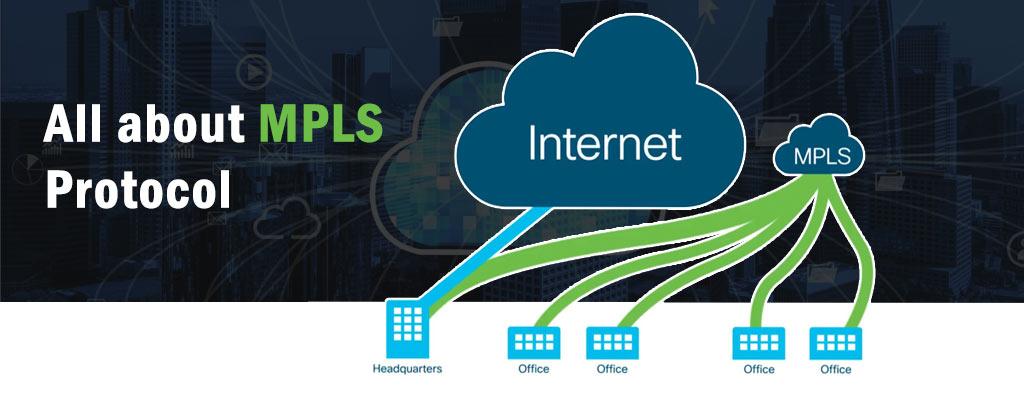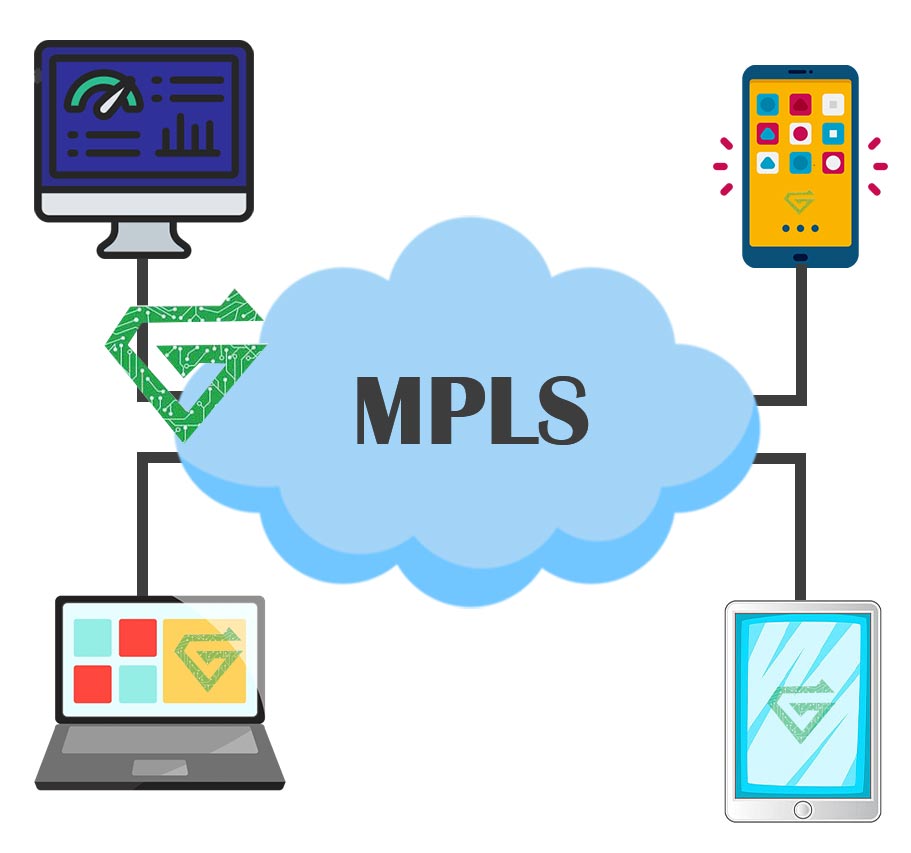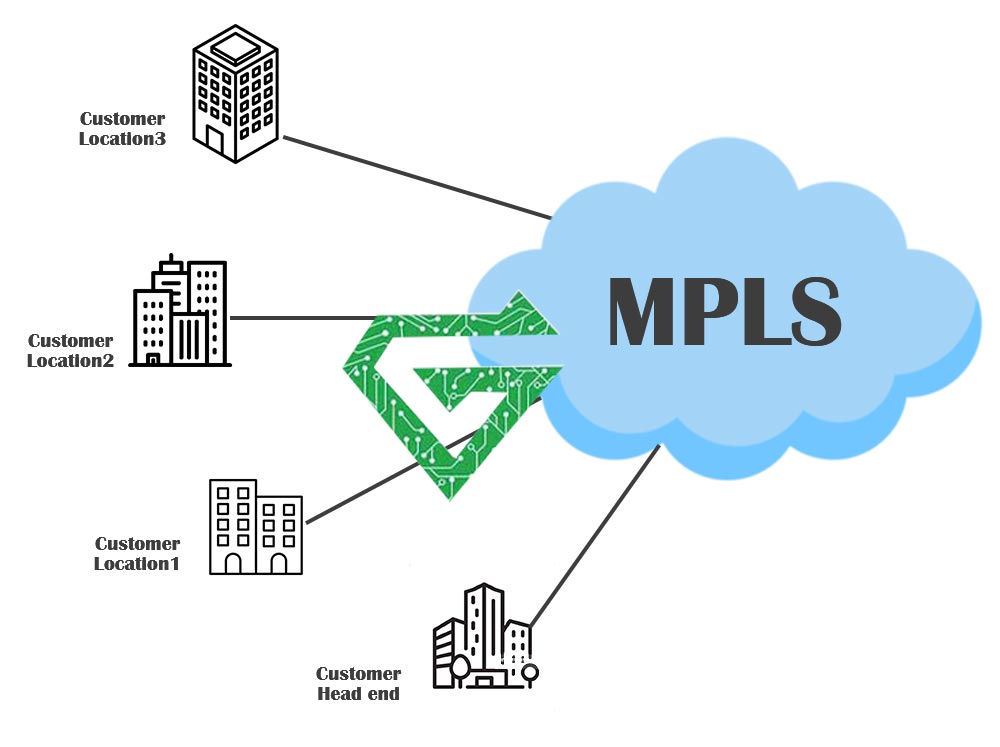All about MPLS Protocol

Network is an extended technology that progress and improve nowadays. Many protocols are produced by different companies such as cisco. These protocols help network equipment and network devices that work better and professionally.
MPLS is one of the protocols that we are going to explain All about MPLS in this article. You can read other Protocols that suitable for network manager and IT worker, in Atech blog.
What is MPLS?
MPLS (Multiprotocol Label Switching) is a networking protocol used to speed up and manage the flow of network traffic. It directs data from one node to the next based on short path labels rather than long network addresses, avoiding complex lookups in a routing table.
MPLS is a new protocol and uses instead of network addresses for routing the traffic with shorter pathway.
Every path arrives at requires another forwarding decision until it arrives at its destination. MPLS Protocol is able to result in poor performance for users, the applications they are using and impact the network across an organization.
This protocol can decrease downtime and make a better speed and quality of service or QoS. MPLS routers don’t look up in routing tables and this is one of the reasons to increase speed of network traffic. This protocol has a significant role in supporting legacy network technologies.
Key Concepts of MPLS:
- Label Switching: Instead of using IP addresses to make routing decisions, MPLS assigns a label to each packet. Routers (called Label Switch Routers, or LSRs) use these labels to forward packets quickly.
- Multiprotocol: MPLS is not tied to any specific data-link layer protocol. It can work over Ethernet, ATM, Frame Relay, etc.
- Efficient Forwarding: Because routers just look at the label (not the full IP header), forwarding is faster.
- Traffic Engineering (TE): MPLS can manage bandwidth and route traffic based on performance, which is great for Quality of Service (QoS).
- VPN Support: It’s often used by ISPs to create Layer 3 VPNs (MPLS VPNs), connecting multiple customer sites over a shared backbone securely and efficiently.

What does MPLS Protocol do?
MPLS (Multiprotocol Label Switching) is like a traffic manager for network data. Here’s what it does in practical terms:
- Speeds Up Data Forwarding
Instead of routers analyzing every packet’s IP address, MPLS uses labels. These labels are like shortcuts, letting routers forward packets faster.
Think of it like toll booths: instead of checking your license plate every time, you get a fast-pass sticker (the label) and zoom through.
- Creates Predetermined, Efficient Paths (Label Switched Paths)
MPLS sets up predefined routes across the network for different types of traffic. This avoids congestion and improves efficiency.
Like giving VIP traffic its own express lane.
- Supports Traffic Engineering
Network admins can control how traffic flows, choosing paths that avoid congestion or meet performance needs (like low latency or high bandwidth).
- Enables VPN Services
ISPs use MPLS to build secure, isolated networks (VPNs) for different customers across a shared infrastructure.
Like having multiple private roads on the same physical highway.
- Improves Quality of Service (QoS)
MPLS Protocol can prioritize certain types of traffic, like video calls or voice over IP, so they’re less likely to lag or drop.
- Supports Redundancy and Fast Rerouting
If a path fails, MPLS can reroute traffic very quickly without needing to recalculate routing tables from scratch.
Read more: HTTP vs HTTPS
How does MPLS help to network?
MPLS Protocol helps networks in:
- Move data faster
- Control where traffic goes
- Build secure VPNs
- Prioritize important traffic
- Quickly recover from failures
Read more: What is NetFlow protocol
Types of MPLS:
- Layer 2 point to point: This type of MPLS is good for companies and organizations that need high bandwidth connections connecting a few locations together while maintaining cost-effectiveness. Layer 2 point to point is an excellent alternative to high bandwidth leased lines.
- Layer 2 virtual private LAN Services (VPLS): this type is now becoming more sought after for its ability to provide Ethernet services. Layer 2 VPLS combines the multi-protocol labels switching with the Ethernet and extends the benefits to end customers and carriers.
- Layer 3 IP/VPN: This type of MPLS is good for large enterprises covering multiple branches over a vast land mass. This includes corporations with offices spread across the globe, industries located in more than one country, etc.

MPLS Feature?
Here are the main features of MPLS Protocol that make it powerful and widely used in enterprise and service provider networks:
- Label-Based Forwarding
- Each packet is assigned a short label.
- Routers forward packets based on labels instead of full IP lookups.
- Speeds up packet processing and reduces complexity.
- Traffic Engineering (TE)
- MPLS can direct traffic based on specific policies (not just the shortest path).
- Helps balance network load and avoid congestion.
- Enables optimal use of available network resources.
- Quality of Service (QoS)
- Supports prioritization of different traffic types.
- Ensures high performance for latency-sensitive applications (e.g., VoIP, video).
- You can set rules like: voice > video > file downloads.
- Scalability
- Efficient for large networks with complex topologies.
- Works well with many customers and routes in large-scale ISPs.
- VPN Support
- Allows creation of Layer 3 VPNs (MPLS VPN).
- Securely connects remote branches over shared infrastructure.
- Keeps each customer’s data isolated.
- Protocol Independence
- Works over various Layer 2 technologies: Ethernet, Frame Relay, ATM, etc.
- Supports both IPv4 and IPv6.
- Fast Reroute / High Availability
- MPLS Protocol can quickly reroute traffic if a link fails (within milliseconds).
- Minimizes downtime and ensures continuous service.
- Separation of Control and Data Plane
- Label assignment and path computation can be managed independently.
- Simplifies network management and increases flexibility.
- Integration with Other Technologies
- Works well with BGP, OSPF, IS-IS, and RSVP-TE.
- Forms the backbone of technologies like Segment Routing and SD-WAN.
What is MPLS protocol used for?
Most of organizations use this technology when they have multiple remote branches in all over the country or world and need to access data center or applications in other branches. This protocol is very practical and provides good performance and bandwidth.
Although this is useful and practical, some bad points it has. MPLS Protocol is costly and deliver it to the world is difficult. It is not flexible to be carrier independent.
Totally MPLS protocol used for:
- ISPs and large enterprise networks
- VoIP and video traffic optimization
- Connecting remote branch offices via MPLS VPNs
How does MPLS Work?
If we want to talk about its work briefly;
- Ingress router: Receives the packet, attaches an MPLS label based on the destination.
- Label switch routers (LSRs): Forward the packet based on the label, not the IP header.
- Egress router: Removes the label and delivers the packet based on IP again.
But for explaining better and step by step follow this part:
- Packet Enters the MPLS Network
- A packet arrives at the ingress router (entry point).
- The router examines the destination IP address.
- Based on its routing table and policies, it assigns a label to the packet.
- Labels are short, fixed-length identifiers (e.g., 20 bits).
- The label is added between Layer 2 (e.g., Ethernet) and Layer 3 (IP) → This is called a shim header.
- Label Switching Through the Network
- As the packet travels through the MPLS network, it passes through Label Switch Routers (LSRs).
- Each router:
- Looks only at the label, not the IP header.
- Swaps the label with a new one (based on the next hop).
- Forwards the packet to the next router.
- This process is called label swapping.
- Label Switched Path (LSP)
- The path from the ingress to the egress router is a Label Switched Path.
- It’s pre-determined based on policies, not dynamically chosen like normal IP routing.
- Packet Exits at the Egress Router
- The final router (egress) removes the MPLS label.
- It forwards the original IP packet to its destination using regular IP routing.
Visualization:
[Host A] → [Ingress Router] ──▶[LSR]──▶[LSR]──▶[Egress Router] → [Host B]
Label: 100 Label: 200 Label: 300 No Label

Architecture of MPLS protocol:
The architecture of MPLS (Multiprotocol Label Switching) is designed to efficiently route packets across a network using labels instead of IP addresses at each hop. Here’s a breakdown of its structure and key components:
MPLS Protocol works between Layer 2 (Data Link Layer) and Layer 3 (Network Layer), often called Layer 2.5 and is composed of several functional elements:
Label Edge Routers (LERs)
- Also called Ingress and Egress routers.
- Ingress LER: Entry point to the MPLS network. It classifies the incoming IP packet and assigns an MPLS label.
- Egress LER: Exit point. It removes the MPLS label and forwards the packet using normal IP routing.
Label Switch Routers (LSRs)
- Core routers inside the MPLS network.
- Perform label swapping:
- Receive a packet with a label.
- Lookup the label in their forwarding table.
- Replace it with a new label and forward it.
Label Switched Path (LSP)
- A predefined route that a packet follows through the MPLS network.
- Set up from ingress to egress LER.
- Unidirectional path: each direction (A ➝ B and B ➝ A) has its own LSP.
Labels
- 20-bit identifiers added to packets.
- Each label represents a FEC (Forwarding Equivalence Class) a group of packets forwarded the same way.
Control Plane Protocols
Responsible for label distribution and LSP setup:
- LDP (Label Distribution Protocol) commonly used for distributing labels.
- RSVP-TE used for MPLS Traffic Engineering.
- BGP/MPLS for MPLS VPNs.
- OSPF/IS-IS for routing within the MPLS domain.
Data Plane
- Where actual packet forwarding happens using label lookups and switching.
- Fast and efficient — minimizes route processing delay.
Forwarding Information Base (FIB) + Label Forwarding Information Base (LFIB)
- FIB: Used for IP routing.
- LFIB: Stores label-to-label forwarding mappings.
Diagram of MPLS Architecture (Text View)
[Host A]
|
[Ingress LER] — (Label Imposed)
|
[LSR] — (Label Swapped)
|
[LSR] — (Label Swapped)
|
[Egress LER] — (Label Removed)
|
[Host B]
The most important key points of MPLS Protocol:
- Fast forwarding: Routers don’t inspect full IP headers—just quick label lookups.
- Flexible routing: You can steer traffic through specific paths (great for congestion control or QoS).
- Supports VPNs and traffic engineering with high reliability.
Conclusion:
MPLS is one of important and practical protocols that helps to network manager a lot. in this article, we explained different aspect of it and try to describe its work, uses, features and etc. if you want to know other protocols related to network and network devices, look up our other articles in Atech blog.





